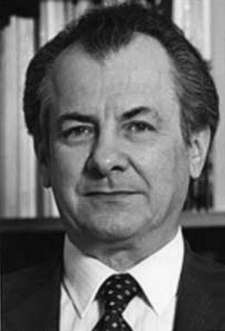Gérard de Vaucouleurs
Gérard Henri de Vaucouleurs (25 April 1918 – 7 October 1995) was a French astronomer.
Gérard de Vaucouleurs | |
|---|---|
 | |
| Born | Gérard Henri de Vaucouleurs 25 April 1918 Paris, France |
| Died | 7 October 1995 (aged 77) |
| Nationality | |
| Alma mater | Lycee Charlemagne (BSc, 1936)[1] Sorbonne (PhD, 1949) |
| Known for | De Vaucouleurs' law |
| Spouse(s) | Antoinette de Vaucouleurs (m. 1944; her death 1988) |
| Awards | Henry Norris Russell Lectureship (1988) Prix Jules Janssen (1988) |
| Scientific career | |
| Fields | Astronomy |
| Institutions | Yale University Observatory Lowell Observatory Harvard College Observatory University of Texas at Austin |
Life and career
Born in Paris, he had an early interest in amateur astronomy and received his undergraduate degree in 1939 at the Sorbonne in that city. After military service in World War II, he resumed his pursuit of astronomy.
Fluent in English, he spent 1949–51 in England, 1951–57 in Australia, the latter at Mount Stromlo Observatory, 1957–58 at Lowell Observatory in Arizona and 1958–60 at Harvard. In, 1960 he was appointed to the University of Texas at Austin, where he spent the rest of his career. He died of a heart attack in his home in Austin at the age of 77.[2]
His earliest work had concerned the planet Mars and while at Harvard he used telescope observations from 1909 to 1958 to study the areographic coordinates of features on the surface of Mars.[3] His later work focused on the study of galaxies and he co-authored the Third Reference Catalogue of Bright Galaxies with his wife Antoinette (1921-1987), a fellow UT Austin astronomer and lifelong collaborator.[4] His specialty included reanalyzing Hubble and Sandage's galaxy atlas and recomputing the distance measurements utilizing a method of averaging many different kinds of metrics such as luminosity, the diameters of ring galaxies, brightest star clusters, etc., in a method he called "spreading the risks." During the 1950s he promoted the idea that galactic clusters are grouped into superclusters.[2]
The de Vaucouleurs modified Hubble sequence is a widely used variant of the standard Hubble sequence.
De Vaucouleurs was awarded the Henry Norris Russell Lectureship by the American Astronomical Society in 1988. He was awarded the Prix Jules Janssen of the Société astronomique de France (Astronomical Society of France) in the same year. He and his wife and longtime collaborator, Antoinette de Vaucouleurs, together produced 400 research and technical papers, 20 books and 100 articles for laymen.[2]
See also
References
- "Gerard Henri de Vaucouleurs (1918 - 1995)". American Astronomical Society. Retrieved 29 June 2017.
- Thomas Jr., Robert McG. (October 11, 1995), "Gerard de Vaucouleurs, 77, Galactic Astronomer, Is Dead", The New York Times, retrieved 2012-02-21
- de Vaucouleurs, Gerard (1963), "La Physique des Planetes; Communications Presentees au Onzieme Colloque International d'Astrophysique tenu a Liège, les 9, 10 et 11 Juillet 1962.", Liege International Astrophysical Colloquia, 11: 369–385, Bibcode:1963LIACo..11..369D
|chapter=ignored (help) - Memoriam to Antoinette de Vaucouleurs from University of Texas Austin
- Lahav O; Naim A; Buta RJ; et al. (1995), "Galaxies, Human Eyes, and Artificial Neural Networks", Science, 267 (5199): 859–62, arXiv:astro-ph/9412027, Bibcode:1995Sci...267..859L, doi:10.1126/science.267.5199.859, PMID 17813914
- de Vaucouleurs, G (1993), "Tests of the long and short extragalactic distance scales", PNAS, 90 (11): 4811–4813, Bibcode:1993PNAS...90.4811V, doi:10.1073/pnas.90.11.4811, PMC 46605, PMID 11607392
- Masursky H; Batson RM; McCauley JF; et al. (1972), "Mariner 9 Television Reconnaissance of Mars and Its Satellites: Preliminary Results", Science, 175 (4019): 294–305, Bibcode:1972Sci...175..294M, doi:10.1126/science.175.4019.294, PMID 17814535
- de Vaucouleurs, G; Wertz, JR (1971), "Hierarchical big bang cosmology", Nature, 231 (5298): 109, Bibcode:1971Natur.231..109D, doi:10.1038/231109a0, PMID 16062575
- de Vaucouleurs, G (1970), "Postscript", Science, 168 (3934): 917, doi:10.1126/science.168.3934.917-a, PMID 17844177
- de Vaucouleurs, G (1970), "The Case for a Hierarchical Cosmology", Science, 167 (3922), pp. 1203–1213, Bibcode:1970Sci...167.1203D, doi:10.1126/science.167.3922.1203, PMID 17751407
External links
- Obituary: Gerard Henri De Vaucouleurs, 1918-1995
- Biography
- http://nedwww.ipac.caltech.edu/level5/normal_galaxies.html
- National Academy of Sciences Biographical Memoir